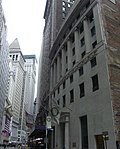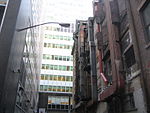Millennium High School (New York City)
Broad Street (Manhattan)Financial District, ManhattanPublic high schools in Manhattan

Millennium High School is a selective public high school for grades 9 through 12 in Manhattan. It is operated by the New York City Department of Education in Region 9 and is ranked 77th within New York State and 688th nationwide by the U.S. News. The Phoenix is the school's mascot, meant to symbolize the school rising from the ashes of the World Trade Center following the September 11 attacks. In 2016, the school received more than 6,000 applications for 170 seats, yielding an acceptance rate of less than 3%. Admission to MHS is based on selective criteria including a middle school GPA of 90 or above, attendance, and state test scores in reading and math.
Excerpt from the Wikipedia article Millennium High School (New York City) (License: CC BY-SA 3.0, Authors, Images).Millennium High School (New York City)
Broad Street, New York Manhattan
Geographical coordinates (GPS) Address Nearby Places Show on map
Geographical coordinates (GPS)
| Latitude | Longitude |
|---|---|
| N 40.704606 ° | E -74.011444 ° |
Address
Broad Street 75
10004 New York, Manhattan
New York, United States
Open on Google Maps








